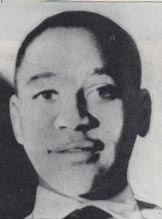"Bye Baby"
On August 25, 1955 Emmett Louis Till was murdered by Roy Bryant and
J.W.  Milam.
Till had scolded his cousins for kowtowing whites in the South. Till
from Chicago in the north and he did not believe it was right for a
person to kowtow to a white person just because he was black. A kowtow
is a form of bowing from the Orients in which the person must have their
heads touch the floor nine times. Till had also went to the Bryant store
and Mrs. Bryant was at the counter. When he had left, he had said "Bye,
Baby." Those words would cost him his life.
Milam.
Till had scolded his cousins for kowtowing whites in the South. Till
from Chicago in the north and he did not believe it was right for a
person to kowtow to a white person just because he was black. A kowtow
is a form of bowing from the Orients in which the person must have their
heads touch the floor nine times. Till had also went to the Bryant store
and Mrs. Bryant was at the counter. When he had left, he had said "Bye,
Baby." Those words would cost him his life.
Till was dragged from his home, shot in the head, and was dumped in
the Tallahatchie River with a cotton gin tied down at his neck. His
body was disfigured so bad that the only way his family identified him
was by a ring he wore on his finger. Emmett Louis Till's mother had
an open casket at her son's funeral to let the world know the injustice
that had been committed. Despite the legal help and confessions from
the killers, the all-white jury returned a not guilty verdict without
much deliberation.
Morris Dees was merely a teenager at college at the time. Yet, the
story of Emmett Louis Till touched in. When he thought of Till, he thought
of the friends he had met and played with on the Mount like Mount Meigs.
Morris decided to write a letter.
"Maybe we believe in segregation, but we also believe in justice. If
this young man did something illegal, then he ought to be tried and
convicted before he is punished , not lynched." Morris wrote to a newspaper
in Tuscaloosa. His letter was published.
Segregation and Education
From high school and marriage, Morris Dees went on to college. When
school opened in September of 1955, the University of Alabama was still
all white. In 1954, the United States Supreme Court had ruled that there
was no equality in schools if they were to remain segregated. One year
after that decision, no black person had yet decided to enroll in the
University of Alabama.
In fact, many governors in the South including George Wallace ignored
the Court's ruling and continued to segregate schools. It was one of
the many tactics to keep the blacks in the South from getting power
and equality.
In 1956, Autherine Lucy challenged the University of Alabama. A federal
court had ordered that the University admit Autherine Lucy. On the first
day of school, Lucy walked to school through an angry mob of whites
throwing and cursing her. She was accompanied only by a priest. Thousands
of people gathered at the University that day, including many members
of the Ku Klux Klan. They threw bricks and bottles at her car. And they
shouted "Nigger, go home!"
The students at the University were told to stay in their rooms. Morris
came out because of curiosity. He wasn't sympathetic, but rather curious.
But as soon as he went outside, as soon as he saw Autherine Lucy's face,
he felt disgusted and wanted to leave. He saw yet again the faces of
his friends from Mount Meigs in Lucy's face. He saw Little Buddy, Miss
Perri Lee, Wilson and many more.







